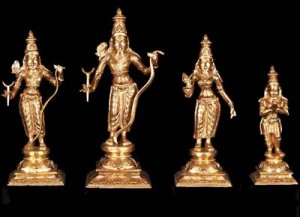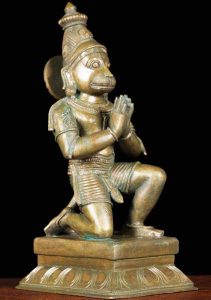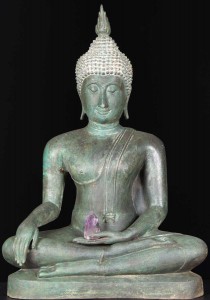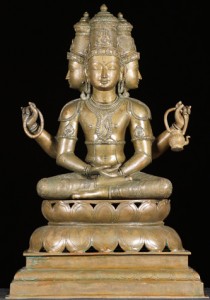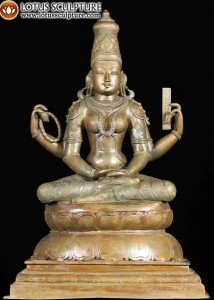Karna is a fascinating character in the Mahabharata epic. He is depicted as a tragic hero; gifted, righteous and brave, whose warrior skills won the admiration of Bhishma and Krishna. He remains as a tragic figure for millions of Hindus and Indians. The story of Karna not only portrays his warrior skills, generosity, but also the strong friendship he had with Duryodhana, the eldest of Kauravas.
Birth of Karna: Karna is the eldest illegitimate son of Kunti, the mother of the Pandava clan. When Kunti was a teenage girl, she got the opportunity to serve the great saint Durvasa. She took great care of him, which pleased him so much that he blessed her with a varada or boon. The boon were the words to a powerful mantra. Whenever she chooses to chant this mantra she will have a baby boy endowed with Godly qualities from any God she wants.
As a teenage girl, without thinking of the consequences, Kunti decided to test the mantra. While reciting the mantra, she pictured Surya the Sun God. To her wonder Surya appeared before her in resplendent glory. Kunti was terrified by Surya as she never expected him to come. She wanted him to go back, but it was not possible since he was bounded by the strength of the mantra.
Kunti was blessed with a pretty boy, named Karna, and she was surprised to see the protective armor over his chest and in his ears – the kavacha and kundalas. Because she was a single teenage mother she was left with no choice but to give up the baby. She prepared a basket for her child and left him in the holy Ganges to float away from her life.
Karna was spotted by a couple named Adhiratha and Radha who desperately wanted a child of their own. The couple adopted him and found happiness in raising him. He came to be known as Suta Puthra as his father, Adhiratha, was the charioteer of King Dhritarashtra. Karna was also known as Vasusena (Born with wealth) and Radheya (as his mother’s name was Radha).
Education: As a youth, Karna wanted to become a great warrior and learn archery and martial arts. He contacted Guru Dronacharya and pleaded him to teach the art of warfare, but the guru refused his request as Karna belonged to low caste. Karna realized that he could never fulfill his ambition as his lowly caste would prevent anyone from taking him on to teach him.
Curses: Hiding his identity Karna contacted Parshuram, a great warrior, and revealed his desire to be his disciple. Mistaking him as a Brahmin, Parashuram accepted him. He taught him to master all the weapons of war. Parashuram later discovered that he was deceived by Karma. He placed a curse on Karna that all he learned from Parashuram would not be useful to protect him at the most crucial juncture in his life when he needs it most.
A second curse was placed on Karna while he was practicing the archery and he accidentally missed the target and killed a sacred cow. A brahmin saw this and cursed him that he will have to face death as his innocent cow did; defenseless.
Karna’s natural mother, Kunti eventually was married to Pandu the King of Hastinapura, and he exhorted her to use the mantra and gave birth to three sons – Yudhishthir, Bhim and Arjun. Madri, the second wife of Pandu, gave birth to Nakul and Sahadev. The five brothers came to be known as sons of Pandu -the Pandavas and lived with Kauravas, the sons of Dhritarashtra, Pandu’s elder brother. The Kauravas and Pandavas were master warriors learning all their skills from Kripacharya and then from Dronacharya. However, all was not well between the brothers and the Kauravas and Pandavas had a dispute which eventually started a war between the two families.
The friendship with Duryodhana begins: Karna came to the arena of the great event organized by Dronacharya to showcase his disciple’s skills. At the arena Karna challenged Arjun to a duel. Duryodhana, the King of India and eldest of the Kauravas, was very happy to hear of Karna’s challenge to Arjun. Duryodhana was very jealous of Arjun’s skill and wanted to defeat the Pandavas by all means. However, the combat was declined since, Karna belonged to a low caste and Arjun was a prince. Duryodhana came to the help of Karna and announced that Karna was the king of Anga. From this moment, Karna became loyal to Duryodhana and a friendship grew between them.
Kunti meets Karna: The dispute between the Pandavas and Kavravas, regarding the right to rule Hasthinapur, eventually led to the Kurushethra war. Before the war begins, Kunti meets Karna and reveals the truth that she is his biological mother. She asks him to leave Kauravas and join his half-brothers. However, the loyal Karna denies his mother’s request and promises that she will be left with five sons at the end of the battle as he only wishes to kill Arjun. He also requests his mother to keep their relationship and his royal birth heritage a secret until his death. Indra, the father of Arjun, becomes worried and disguises himself as a Brahmin and asks the generous Karna to give away his armor bestowed on his as a child as a gift for him. Despite of the warning from his father, Surya, Karna fulfills the wish of the masked Brahmin and gifts his armor away.
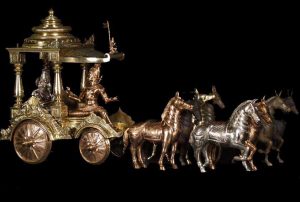
Battle of Kurushethra: In the Mahabharata war Karna fights on the Kauravas’ side and opposes his own half-brothers, the Pandavas. Lord Krishna becomes the charioteer of Arjun, to see that the Pandavas win the battle. Karna enters the battlefield on the 11th day, after Bhishma was wounded. He kept his word to Kunti and did not capture any of the Pandavas, even though he has several opportunities to do so. On the 15th day, Karna is appointed as the commander-and-chief of the Kaurava forces as Drona was killed by unfair means. Karna was able to defeat all the Pandavas, except Arjun in the individual confrontations, but spares their lives as he does not want to break the promise he had given to his mother.
On the 17th day, Karna and Arjun come face to face in battle. Karna tried his hardest to kill Arjun and Lord Krishna came to the rescue of Arjun. During the course of battle, one of the wheels of Karna’s chariot plunges into the earth’s loose soil. Karna asks Arjun to temporarily stop the fighting, which Arjun agrees to. Karna gets off his chariot unarmed and to fix the wheel of the chariot. During this, Lord Krishna reminds Arjun about the incidents in which his wife Draupati was disgraced and Karna’s role in the death of his son Abhimanyu. Arjun was so desperate that he obeyed the advice of Krishna and aimed the fatal shaft Anjalika at Karna. Though Karna was able to protect himself from the arrow, he couldn’t do it. The curse which was placed upon him by his former teacher, Parshuram worked and he was unable to protect himself and the arrow hit him.
Salvation: Lord Krishna meets Karna in the battle field just before his death and promises to grant him any two wishes. Karna asks Krishna to inform his mother, Kunti, about his death so that she can reveal the secret that he was the eldest of the Pandavas. For his 2nd wish he wanted his rebirth to be in a noble family so that he can feed others (annatanam). Lord Krishna was very much moved by his requests and informs him that in the next life he will be Siruttontar Nayanar and finally the brave and courageous hero dies in harmony.
After his conversation with Krishna, Karna was then beheaded brutally as he was helpless in the battle field fulfilling the curse of the brahim saying he would die defenseless. All the curses worked upon him at once in the battle.
What are the reasons for Karna’s downfall? What paved the path for his ultimate destruction? His dedicated friendship and support for Duryodhana’s malicious plans or his generosity in giving away things without considering his own safety?

